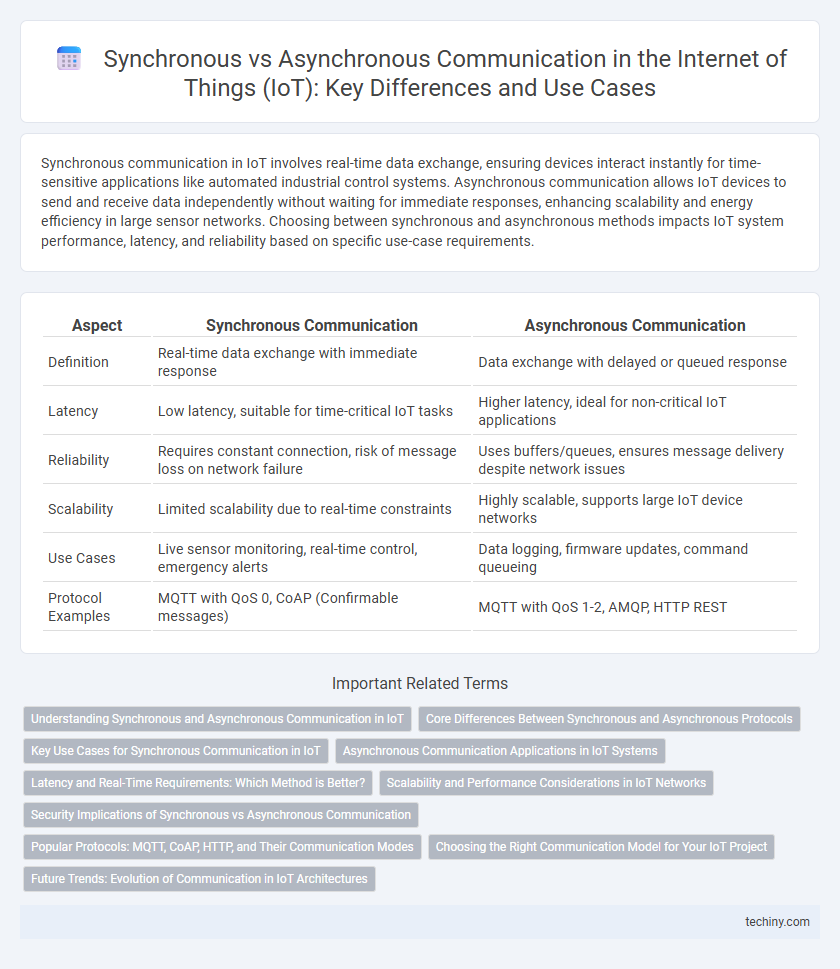Synchronous communication in IoT involves real-time data exchange, ensuring devices interact instantly for time-sensitive applications like automated industrial control systems. Asynchronous communication allows IoT devices to send and receive data independently without waiting for immediate responses, enhancing scalability and energy efficiency in large sensor networks. Choosing between synchronous and asynchronous methods impacts IoT system performance, latency, and reliability based on specific use-case requirements.
Table of Comparison
| Aspect | Synchronous Communication | Asynchronous Communication |
|---|---|---|
| Definition | Real-time data exchange with immediate response | Data exchange with delayed or queued response |
| Latency | Low latency, suitable for time-critical IoT tasks | Higher latency, ideal for non-critical IoT applications |
| Reliability | Requires constant connection, risk of message loss on network failure | Uses buffers/queues, ensures message delivery despite network issues |
| Scalability | Limited scalability due to real-time constraints | Highly scalable, supports large IoT device networks |
| Use Cases | Live sensor monitoring, real-time control, emergency alerts | Data logging, firmware updates, command queueing |
| Protocol Examples | MQTT with QoS 0, CoAP (Confirmable messages) | MQTT with QoS 1-2, AMQP, HTTP REST |
Understanding Synchronous and Asynchronous Communication in IoT
Synchronous communication in IoT involves real-time data exchange where devices transmit and receive information simultaneously, ensuring immediate responses crucial for applications like industrial automation and remote control systems. Asynchronous communication allows devices to send data independently without waiting for an immediate response, optimizing power consumption and enabling scalable networks in scenarios such as sensor data collection and predictive maintenance. Choosing between synchronous and asynchronous methods depends on IoT system requirements for latency, reliability, and resource efficiency.
Core Differences Between Synchronous and Asynchronous Protocols
Synchronous communication in IoT relies on coordinated timing between devices, ensuring data exchange occurs simultaneously and often requires continuous connectivity. Asynchronous communication allows devices to transmit data independently without waiting for a response, enabling greater flexibility and efficiency in low-power or intermittent network environments. Protocols like MQTT favor asynchronous messaging for scalability, while synchronous protocols such as Modbus are preferred for real-time data accuracy in industrial IoT applications.
Key Use Cases for Synchronous Communication in IoT
Synchronous communication in IoT is essential for real-time applications such as industrial automation, smart grid control, and telemedicine, where immediate data exchange and response are critical. This communication method ensures low latency and precise timing, enabling seamless coordination between sensors, actuators, and control systems. Key use cases include robotic assembly lines, remote surgery, and power distribution management, where timing accuracy and reliability directly impact system performance and safety.
Asynchronous Communication Applications in IoT Systems
Asynchronous communication in IoT systems enables devices to transmit data independently without waiting for a synchronized clock signal, enhancing flexibility and reducing latency in data processing. This communication mode is crucial for IoT applications such as smart agriculture, remote monitoring, and asset tracking, where devices operate intermittently and require efficient power management. Implementing asynchronous protocols like MQTT and CoAP optimizes bandwidth usage and supports scalable, real-time data exchange across distributed IoT networks.
Latency and Real-Time Requirements: Which Method is Better?
Synchronous communication in IoT offers low latency and reliable real-time data exchange, making it ideal for time-sensitive applications like industrial automation and healthcare monitoring. Asynchronous communication provides higher scalability and flexibility but often incurs variable latency, which may not meet strict real-time requirements. For applications demanding immediate response and minimal delay, synchronous communication is generally better suited in the IoT ecosystem.
Scalability and Performance Considerations in IoT Networks
Synchronous communication in IoT networks offers low latency and predictable timing, making it suitable for real-time applications but limiting scalability due to strict coordination requirements among devices. Asynchronous communication enhances scalability by allowing devices to transmit data independently, reducing network congestion and improving overall performance in large-scale IoT deployments. Selecting between synchronous and asynchronous methods depends on balancing real-time responsiveness with the ability to efficiently manage numerous connected IoT devices and data flows.
Security Implications of Synchronous vs Asynchronous Communication
Synchronous communication in IoT, characterized by real-time data exchange, poses higher risks of interception and data breaches due to continuous open channels, necessitating robust encryption and authentication protocols. Asynchronous communication enhances security by reducing exposure time since devices send and receive data at different intervals, minimizing attack windows and enabling efficient use of secure queue-based message handling. Implementing secure asynchronous models with message integrity checks and delayed acknowledgment mechanisms strengthens resilience against replay attacks and unauthorized data tampering in IoT networks.
Popular Protocols: MQTT, CoAP, HTTP, and Their Communication Modes
MQTT employs asynchronous communication, enabling efficient message delivery in IoT devices with limited bandwidth and power by using a publish-subscribe model. CoAP supports asynchronous interactions over UDP, optimizing low-power and lossy networks for fast, reliable data exchange in constrained environments. HTTP primarily uses synchronous request-response communication, leading to higher latency and resource consumption but ensuring compatibility with web standards in IoT applications.
Choosing the Right Communication Model for Your IoT Project
Selecting the appropriate communication model for an IoT project depends on factors such as latency requirements, power consumption, and network reliability. Synchronous communication offers real-time data exchange suitable for time-sensitive applications like industrial automation, while asynchronous communication supports intermittent data transmission, benefiting low-power devices and scenarios with sporadic connectivity. Evaluating the trade-offs between synchronous and asynchronous methods ensures optimized performance and efficient resource utilization in IoT deployments.
Future Trends: Evolution of Communication in IoT Architectures
Future trends in IoT architectures emphasize the growing integration of asynchronous communication to enhance scalability and reduce latency in complex networks. Synchronous communication remains vital for real-time applications requiring immediate data exchange, such as autonomous vehicles and industrial automation. Emerging hybrid models leverage both methods, optimizing energy efficiency and improving fault tolerance in expansive IoT ecosystems.
Synchronous communication vs Asynchronous communication (IoT context) Infographic

 techiny.com
techiny.com